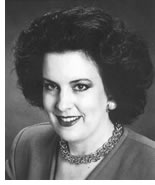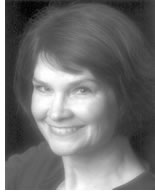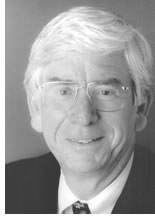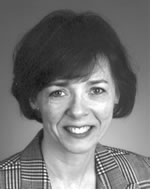

2/2006

We would like you to welcome nine very special people into the AIA family. They are individuals who, although not architects by profession, have given distinguished service to the profession of architecture or the allied arts and sciences, and thus have made all of our lives richer. One of the most important messages we share is gratitude toward those who support and uplift architects and architecture; in this spirit, the Institute is very pleased to bestow on these nine individuals the title of Honorary AIA.
 Torrey Stanley Carleton, Hon. AIA, Hon. TSA
Torrey Stanley Carleton, Hon. AIA, Hon. TSA
Under Torrey Stanley Carleton’s 13 years of leadership as executive
director, AIA San Antonio has grown in both size and revenue by more
than 50 percent. Her innovative programming has included the chapter’s
popular annual Beaux Arts Ball, which has brought in more than $65,000
and allowed the chapter to establish an endowed scholarship at the University
of Texas at San Antonio’s College of Architecture and to fund the
school’s AIA San Antonio Lecture Series. Carleton also was instrumental
in establishment of the chapter’s annual Town & Country Homes
Tour, now in its 10th year. She also has forged an innovative partnership
with San Antonio Woman magazine (circulation, 25,000), that enabled the
chapter to place a 16-page full-color insert about the tour.
Carleton also has prepared more than 25 TSA Honor Award submittals and coordinated three Texas Society of Architects state conventions. She currently is serving as a member of the 2006 AIA National Convention Committee. “I have no doubt that Ms. Carleton’s dedication to the Institute’s mission: serving our Chapter’s members, advancing their value, and improving the quality of the built environment, has been a major component of the dramatic and steady increase in our Chapter membership from 296 in 1993 when she began her role a executive director to 436 members this year,” wrote 2005 AIA San Antonio President J. Douglas Lipscomb, AIA, in his letter of nomination. “She is a person with a large vision with regard to the AIA and the architecture profession and her wisdom has been instrumental in the success of our chapter.”
 Peter Chapman, Hon. AIA
Peter Chapman, Hon. AIA
Peter Chapman has served both as the creative force and the handmaiden
of The Taunton Press residential design list of books. From The
Not So Big House by Sarah Susanka, FAIA, published in 1998,
to The
Face of Home by Jeremiah Eck, FAIA, to be published in March
2006, the books Chapman has edited have brought millions of readers
a single, overriding message: that good design matters in the quality
of their lives, and that architects make the difference. Chapman almost
single-handedly created a wholly new category of books in residential
design that have appealed to a broad consumer market. Chapman has edited
and published books across a very broad spectrum of residential design,
from materials to buildings to whimsical garages; they include 100,000
copies of books with the AIA/Taunton Press imprint, established in
2003.
Chapman also has served as a juror for the AIA Minneapolis Home Design Awards and as a guest speaker to AIA state and local chapters. “Through his work as an editor for residential architecture books, Peter Chapman has single-handedly broken down the barrier between the public and great residential architecture,” writes AIA Director Leslie J. Thomas, AIA, in her letter of nomination. “Due to his indispensable work as editor to several groundbreaking residential architecture books tailored to the general public, the general population is more aware and receptive to the value of custom design. His work resulted in the sale of more than a million of these inspiring home design books, thus opening the door of architecture to millions of people.”
 Marilyn Farley, Hon. AIA
Marilyn Farley, Hon. AIA
Marilyn Farley’s 42-year-long career has been devoted to excellence
in federal architecture and design. From 1977–1990, she served as the
U.S. General Services Administration’s program manager for Art
in Architecture. In this capacity, she ensured that the public spaces
in innumerable federal offices, courthouses, and other facilities were
enriched with works by some of America’s most distinguished artists,
including Alexander Calder, Claes Oldenberg, George Segal, Isamu Noguchi,
Milton Glaser, Leonard Baskin, Louise Nevelson, Elsworth Kelly, and Maya
Lin. In 1990, Farley joined what was to become GSA’s Office of
the Chief Architect, where she served as senior policy advisor to the
chief architect and the director of Design Excellence and the Arts.
In these positions, Farley was instrumental in translating the aspiration to re-establish the historic legacy of quality federal architecture into policies and processes that have made a reality in an internationally acclaimed portfolio of public facilities through GSA’s Design Excellence Program. She worked tirelessly with GSA colleagues to craft the policies and procedures that implemented and promulgated this program’s architect selection process. In 2000, Farley published The Design Excellence Program Guide, the definitive resource on GSA architect/engineer selections, which still serves as an essential reference and marks a turning point in raising the level of contemporary federal architecture. “I greatly admire Marilyn’s tremendous energy, her collaborative spirit, and her commitment to design excellence,” writes Thom Mayne, FAIA, Morphosis, in support of Farley’s nomination. “In her work to champion a high level of architecture in federal buildings, she has made a significant, lasting contribution to the profession.”
 Susan Hecht, Hon. AIA
Susan Hecht, Hon. AIA
Susan Hecht joined the AIA national component staff in 1982 as executive
assistant to the corporate secretary. Her singular talents were soon
recognized and by 1989 she had been promoted to group vice president
of membership services and corporate secretary. Perhaps, says former
AIA Executive Vice President/CEO Norman L. Koonce, FAIA, in his nomination
letter, “the single challenge that best exemplified her organizational
skills was her outstanding leadership in 1988 of the AIA’s Vision
2000 initiative. Vision 2000 was one of the most complex conferences
ever assembled in record time by the AIA, as the issues raised then
still shape the AIA’s strategic planning process today.”
Hecht also played a lead role in developing the first AIA/American Architectural Foundation Accent on Architecture gala in 1990; the event, which enjoys great success among the public and architects alike, is entering its 17th year. After she left the AIA, Hecht worked as a consultant with the AAF on numerous projects that included fundraising, creation of the highly regarded video documentary Back from the Brink, and strategic planning. Most recently, Hecht served as a management consultant for giving shape to the many ideas generated by the AIA150 Blue Ribbon Panel for the Institute’s sesquicentennial celebration upcoming in 2007. “She has an exceptional depth of knowledge about the culture and the personalities of the organization, a depth that allows her to move diplomatically and with purpose,” writes AIA Kentucky Executive Director Janet D. Pike, Hon. AIA. “Her contributions have been varied, and the impact of her work will be felt throughout the AIA for many years to come.”
 Patricia Harris, Hon. AIA
Patricia Harris, Hon. AIA
Patricia Harris has served as the director of component relations of
the AIA national component for 11 years. “Every component executive
who has a question, whether it’s about a component governance
crisis or as trivial as the weather forecast for an upcoming meeting,
can count on Pat to address their concerns with consummate professionalism,
patience, wisdom, and good humor,” writes Elizabeth Mitchell,
2005 AIA CACE president. “She sets a standard of service that
reflects well on the Institute and challenges component executives
to do the same.”
Throughout her tenure as component relations director, Harris has striven to provide exemplary leadership and service to advance the vision of “One AIA,” while strengthening the credibility of the national component as a supporting partner. Among her many innovations to strengthen relations among members of the AIA family are increasing the number and diversity of workshops offered at the annual Grassroots Leadership Conference, planning and implementing a higher level of national volunteer and staff involvement, and developing an operations manual for components, regarded as the “bible” for AIA chapters. Harris is the recipient of a Presidential Citation from 1990 AIA President Ronald L. Skaggs, FAIA, for her service in working to enhance the effectiveness of both staffed and unstaffed components. “Pat is a shining example of keen professionalism among the employees of the AIA and stands as a model for other staff members to emulate,” writes AIA Community Team Vice President Helene Combs Dreiling, FAIA.
 Randy L. LaVigne, Hon. AIA
Randy L. LaVigne, Hon. AIA
As the executive director for AIA Nevada and AIA Las Vegas since 1994,
Randy LaVigne has dedicated herself to the success of the Institute
and its members. Her vast array of talents shows exemplary achievements
such as assistance in achieving accreditation for the University of
Nevada at Las Vegas School of Architecture, organization of legislative
efforts for members at the local and state levels, founding the award-winning
Architecture Las Vegas magazine, and managing the Western Mountain
Region’s Honor Awards Program. “What Randy gives the AIA
is more than just her skills; it is her passion for architecture and
how architects can make a difference in the community,” writes
Bradley D. Schulz, AIA, who chaired the AIA national convention in
Las Vegas.
Saving her best efforts for the 2005 AIA National Convention in Las
Vegas, LaVigne graciously executed the host chapter activities for the
Institute’s most successful convention ever, earning her a Presidential
Citation. LaVigne also is the proud recipient of a 2003 Award of Distinction
from the Western Mountain Region. “Randy is the epitome of collaboration.
She works with both those represented by the organizational structure
and those outside seeking inclusion to find a solution that serves the
best purposes for all involved,” writes 2005 AIA President Douglas
L Steidl, FAIA. “This was especially evident in her work with the
2005 National Convention, where she consistently worked within the desires
of the local convention committee, the national committee, and the national
staff.”
 Elaine
Ostroff, Hon. AIA
Elaine
Ostroff, Hon. AIA
For more than 30 years, Elaine Ostroff has served as an international
leader and design advocate who has had a significant impact on many
facets of both design practice and education. Considered the “go
to” person for questions on accessibility as well as universal
design, in 1978 she cofounded Boston’s Adaptive Environments
as a nonprofit educational resource center. Now, 23 years later in
its current incarnation as the New England ADA and Information Technology
Center, it is a national source of information on the ADA and the Fair
Housing Act. In 1989, in just one example of her pioneering work, she
developed the Universal Design Education Project involving more than
30 design programs at universities across the country, Europe, and
Japan. Today, known as the Global Universal Design Educators Network,
it supports more than 400 participating educators.
“Elaine Ostroff is someone we all wish to be—a cultural change agent, a leader, a model, an ally, an educator, a brilliant and compassionate (and eminently practical) professional who envisions design as a tool for living and for human dignity,” writes BSA President George Metzger, AIA, in his nomination letter of Ostroff on behalf of the Boston Society of Architects. “Elaine has a special talent for bringing a diverse group of people together in original ways so that they become advocates for a broad spectrum of urban and environmental issues, whether it be universal design and adaptive environments, programs for seniors, issues of ADA compliance, home adaption services, or mental health programs,” writes Elizabeth Ericson, FAIA, principal, Shepley Bulfinch Richardson & Abbott, in support.
 Charles H. Thornton, PhD, PE, Hon. AIA
Charles H. Thornton, PhD, PE, Hon. AIA
Charles H. Thornton is known nationally and internationally as founder
of engineering giant Thompson-Tomasetti Group PC and as an exemplary
corporate leader and innovative civil engineer whose projects include
the Kuala Lumpur City Center in Malaysia, Chifley Tower in Sydney,
Continental Center in New York City, World Financial Center in Battery
Park City, and United Airlines Terminal in Chicago’s O’Hare
Airport. “While all of [his] successes and accomplishments are
worthy nomination justifications by themselves, it is for one of his
volunteer and pro bono accomplishments that Charlie has left perhaps
his greatest legacy,” writes AIA Director Hal P. Munger, AIA,
in his letter of nomination. “Back in 1995, he gathered leaders
in the architecture and construction fields to establish ACE (Architects
Contractors Engineers) Mentoring Program.” Already tens of thousands
of young people across the country have gone through the program, some
have earned scholarships and are now engaging in their life’s
work, an accomplishment they would not otherwise have been able to
achieve.”
Thornton has received an exceptional number of distinguished honors, including election to the National Academy of Engineering in 1997, Honorary Membership in the American Society of Civil Engineers in 1999, Engineering News-Record Award of Excellence in 2001, the Hoover Medal in 2002, and Franklin Institute Laureate in 2003. About Thornton’s founding of the ACE program, Norbert W. Young Jr., FAIA, president of McGraw-Hill Construction, writes, “Our industry desperately needs to attract young folks. The ACE Mentor Program is an after-school simulation of the AEC process, exposing young people to the excitement and value of not only our individual careers, but also the collaborative nature of our industry.”
 Jean R. Valence, Hon. AIA
Jean R. Valence, Hon. AIA
Jean Valence has inspired and guided thousands of individuals and hundreds
of firms as a leader, researcher, teacher, mentor, and innovator in
professional services marketing. Currently vice president of SMMA Inc.,
a 160-person architecture firm in Cambridge, Mass., Valence’s
achievements and contributions to the building industry include being
one of the first marketing professionals to become a partner in an
architecture firm. At one of her earlier firms, Valence’s strategies
and research doubled the firm’s
revenue in four years, and moved it from public work into New England’s
corporate and commercial building markets. A past treasurer and regional
director of the Society for Marketing Professional Services, Valence
is one of seven founders of the SMPS Boston Chapter and the first recipient
of the SMPS Boston Professional Contribution Award.
Valence is equally well known and respected for her contributions to the profession in the areas of education and professional development. Since 1995, Valence has worked to advance education opportunities at the Boston Architectural Center. From 1995–2000, she co-chaired the center’s Education Policy Committee. As an educator, Valence has provided nearly 100 seminars and workshops for the AIA, SMPS, and other groups. She is the author of the 2003 book Architect’s Essentials of Professional Development, as well as numerous journal articles. “I believe that Jean Valence has been instrumental in assisting numerous firms like ours develop professionally to a level beyond what we would have accomplished without her guidance and gentle wisdom,” writes Timothy C. Boers, principal Boulder Associates, in his letter of support for Valence’s nomination. “Her work truly represents distinguished service to our profession.”
Copyright 2006 The American Institute of Architects.
All rights reserved. Home Page ![]()
![]()
![]()